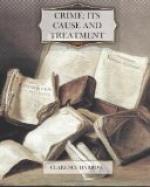JUVENILE CRIMINALS
This subject would scarcely have been noted a few years ago. True, there was in the past a small mixture of children in the grist ground out in the criminal courts. Usually they received some leniency, and were viewed with more curiosity than alarm. The juvenile criminal was regarded as a prodigy with a capacity for crimes far beyond his years. Something of the attitude obtained in regard to him which attaches to the child chess player or the child mathematician. The child criminal is now common, and for the most part is a product of the city.
All crime is doubtless much more common in the city than the country, and the young criminal especially is a product of the crowded community. To those who look for natural causes for all phenomena the reason is not far to seek. The city itself is an abnormal thing. Primitive man and his ancestors were never huddled together in great multitudes, as are the dwellers in cities today. To a degree almost all animals are gregarious, but the units of organization are much smaller with them than with man, excepting possibly in the case of the ant and the bee, insects which seem specially adapted to live a highly automatic and cooperative life, such as human beings cannot possibly reach. But primitive men and their direct ancestors lived in small groups. They could not have preserved their life in any other way. They lived by fishing and hunting and by gathering roots, berries and herbs. Later they tended their flocks and cultivated the fields in a simple way.
With the introduction of the modern machine, the factory system and the railroads, in the last century, our great modern cities were evolved. As they grew more complicated, new problems arose. The life of the crowded city is most difficult even for normal men and women. The adjustments are too numerous and too complex for an animal made with simple tastes and for a pastoral life. But, if it is hard for men, it is almost hopeless for children, especially the children of the poor who fill our prisons, asylums and almshouses.
Every child needs the open air and the open life of the country. He needs, first of all, exercise which should be in the form of outdoor play. No healthy boy wants to live indoors, even though his home may be a convenient city “flat.” The woods, the fields, the streams, the lakes, the wide common with plenty of room, have always made their natural appeal to the young. And as sunlight kills most of the deadly germs, so outdoor life with exercise and play takes care of most of the unhealthy thoughts, habits and ideas of child-life. In the past, our schools both in the city and country have done little to help the young. For the most part healthy children have always looked on them more or less as prisons. Here they have been confined and kept from exercise and play, to study useless and unrelated facts and to commit to memory dry rules which are forgotten as soon as their minds are ready to retain anything worth while.




